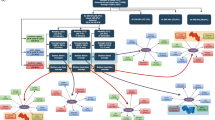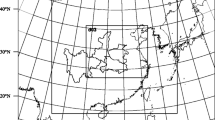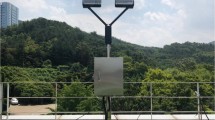Abstract
In this paper, the data collected during the Mesoscale Weather Experiments in East China are utilized to study the meso-α scale rain-bands of meiyu front heavy rain, its structural features as well as the mechanism of its development. It has been revealed that the precipitation band during the meiyu season is in the shape of ribbon, which is parallel to the surface quasi-stationary front. Sometimes two meso-α scale rain-bands are present. The meso-α scale rain-band is associated with meso-α scale convergence line. As shown by the two dimentional disturbance circulation, calculated through band-pass filtering, the single rain-band is quite different from the double rain-bands. The former is, to some extent, akin to the frontogenetical circulation in the vicinity of the high- and low-level frontal zones; the latter features roller-like circulations at middle and low-levels with their axes parallel to the rain-bands while at higher levels they run in the opposite direction. This kind of disturbance may be caused by the symmetric instability in the moist atmosphere.
Similar content being viewed by others
References
Browning, K. A. (1985), Conceptual models of precipitation systems,The Meteorological Magazine,114: 293–318.
Chen Taijen et al. (1980), The structure and vorticity budget of early summer monsoon trough (meiyu) over Southern China and Japan,Mon. Wea. Rev.,108: 942–953.
Gambo, K. (1970), The characteristic feature of medium scale disturbances in the atmosphere (II),J. M. S. J.,48: 315–330.
Kato, K. (1985), On the abrupt change in the structure of the baiu front over the China continent in late May of 1979,J. M. S. J.,63: 20–36.
Lu Hancheng et al. (1985), The feature of meiyu fronts meso-α scale disturbance and the study of stability, Journal of Institute of Meteorology,The PLA Air force.,1: 38–50 (in Chinese).
Matsumoto, S. et al. (1970), On the structure of the “baiu front” and the associated intermediate-scale disturbance in the lower atmosphere,J. M. S. J.,48: 479–491.
Ninomiya, K. (1979), The heavy rain associated with large scale low pressure,The Note of meteorology,138: 142–169 (in Japanese)
Ninomiya, K. (1979), The meso-scale feature of heavy rain,The Note of meteorology,138: 197–230 (in Japanese).
Shapiro, M. A. (1981), Frontogenesis and geostrophically forced secondary circulations in the vicinity of jet stream-frontal zone system,J. A. S.,38: 954–973.
Tao Shiyan et al. (1980),The heavy rain ofChina, Science Press, Beijing, China, pp. 98–114 (in Chinese).
Tokioka, T. (1973), A stability study of medium-scale disturbances with inclusion of convective effects,J. A. S. J.,51: 1–10.
Xia Daching et al. (1983), Some operators for separting meso-scale meteorological fields and their comparisons,Scientia Atmospherica Sinica,7: 303–311 (in Chinese with English abstract).
Yu Zhihao et al. (1985), The feature of the moving rain-clusters in meiyu front, the meeting of meso-scale weather experiments in east China, Nanjing, China (in Chinese).
Author information
Authors and Affiliations
Rights and permissions
About this article
Cite this article
Yang, G., Lu, H. & He, Q. A meso-α scale study of meiyu front heavy rain—Part I: Observational studies. Adv. Atmos. Sci. 4, 264–277 (1987). https://doi.org/10.1007/BF02663597
Received:
Issue Date:
DOI: https://doi.org/10.1007/BF02663597




